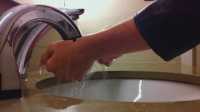
13 Oct Mandated Audit-and-Feedback Did Not Improve Hospital Hand Hygiene
MedicalResearch.com Interview with:
 Dr. Daniel J. Livorsi, MD
Dr. Daniel J. Livorsi, MD
Assistant Professor
INFECTIOUS DISEASE SPECIALIST
University of Iowa
MedicalResearch.com: What is the background for this study? What are the main findings?
Response: One of the Joint Commission’s standards is that hospitals audit and provide feedback on hand hygiene compliance among healthcare workers. Audit-and-feedback is therefore commonly practiced in US hospitals, but the effective design and delivery of this intervention is poorly defined, particularly in relation to hand hygiene improvement.
We studied how 8 hospitals had implemented audit-and-feedback for hand hygiene improvement. We found that hospitals were encountering several barriers in their implementation of audit-and-feedback. Audit data on hand hygiene compliance was challenging to collect and was frequently questioned. The feedback of audit results did not motivate positive change.
MedicalResearch.com: What should readers take away from your report?
Response: Our report shows that improving hand hygiene compliance through audit-and-feedback is challenging.
There is a larger literature on audit-and-feedback that could inform how hospitals’ develop their own audit-and-feedback programs specifically for hand hygiene. In the Discussion section of our article, we refer the reader to some of this literature. However, it remains unclear how some of these approaches to audit-and-feedback can be practically incorporated into real-life hand hygiene improvement programs.
MedicalResearch.com: What recommendations do you have for future research as a result of this work?
Response: Future research should develop strategies for making hand hygiene audit data more credible. This may involve modifying the process of collecting direct observations or developing altogether new audit strategies for hand hygiene compliance (e.g. electronic surveillance). In addition, there is a need to understand how audit data can be fed back in a more effective manner to encourage positive change.
Citation:
[wysija_form id=”3″]
[last-modified]
The information on MedicalResearch.com is provided for educational purposes only, and is in no way intended to diagnose, cure, or treat any medical or other condition. Always seek the advice of your physician or other qualified health and ask your doctor any questions you may have regarding a medical condition. In addition to all other limitations and disclaimers in this agreement, service provider and its third party providers disclaim any liability or loss in connection with the content provided on this website.
Last Updated on October 13, 2018 by Marie Benz MD FAAD
